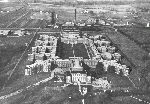Difference between revisions of "Portal:Featured Article Of The Week"
M-Explorer (talk | contribs) |
M-Explorer (talk | contribs) |
||
| Line 1: | Line 1: | ||
{{FAformat | {{FAformat | ||
| − | |Title= | + | |Title= Lima State Hospital |
| − | |Image= | + | |Image= Lima.gif |
|Width= 150px | |Width= 150px | ||
| − | |Body= | + | |Body= Situated on 628 acres (2.54 km²) three miles (5 km) north of downtown Lima, the hospital was constructed between 1908 and 1915. Built at a cost of $2.1 million, it was the largest poured-concrete structure in the country until superseded by the Pentagon. Its walls are at least 14 inches thick, with steel reinforcement going right down to bedrock. |
| − | + | In 1915 Lima State Hospital began receiving it's first patients. Built to house specifically those found guilty of crimes while insane or otherwise too dangerous for the other state run psychiatric institutions. 1953 brought the opening of the Ascherman building, a satellite of the state hospital so the state hospital could start housing regular patients. | |
| + | |||
| + | For much of its history, Lima State Hospital functioned largely as a warehouse. Patients sometimes staged dramatic protests against the conditions of their confinement, and frequently escaped (more than 300 escapes by 1978). Conditions improved significantly after 1974 as a result of a class-action lawsuit filed on behalf of the patients. In a landmark ruling, U.S. District Judge Nicholas J. Walinski spelled out detailed requirements for assuring each patient’s rights to “dignity, privacy and human care.” In its last years, the state hospital was used for the filming of a made-for-television movie about the Attica Prison riots in New York. | ||
| + | |||
| + | In 1982 the building was turned over to the Ohio Department of Corrections and became a medium-security prison, the Lima Correctional Institution. The prison closed in 2004, though a smaller prison on the site, the Allen Correctional Institution, remains. [[Lima State Hospital|Click here for more...]] | ||
}} | }} | ||
Revision as of 04:39, 17 February 2014
Featured Article Of The Week
Lima State Hospital
Situated on 628 acres (2.54 km²) three miles (5 km) north of downtown Lima, the hospital was constructed between 1908 and 1915. Built at a cost of $2.1 million, it was the largest poured-concrete structure in the country until superseded by the Pentagon. Its walls are at least 14 inches thick, with steel reinforcement going right down to bedrock.
In 1915 Lima State Hospital began receiving it's first patients. Built to house specifically those found guilty of crimes while insane or otherwise too dangerous for the other state run psychiatric institutions. 1953 brought the opening of the Ascherman building, a satellite of the state hospital so the state hospital could start housing regular patients.
For much of its history, Lima State Hospital functioned largely as a warehouse. Patients sometimes staged dramatic protests against the conditions of their confinement, and frequently escaped (more than 300 escapes by 1978). Conditions improved significantly after 1974 as a result of a class-action lawsuit filed on behalf of the patients. In a landmark ruling, U.S. District Judge Nicholas J. Walinski spelled out detailed requirements for assuring each patient’s rights to “dignity, privacy and human care.” In its last years, the state hospital was used for the filming of a made-for-television movie about the Attica Prison riots in New York.
In 1982 the building was turned over to the Ohio Department of Corrections and became a medium-security prison, the Lima Correctional Institution. The prison closed in 2004, though a smaller prison on the site, the Allen Correctional Institution, remains. Click here for more...
